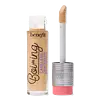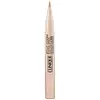What's inside
What's inside
 Key Ingredients
Key Ingredients

 Benefits
Benefits

 Concerns
Concerns

 Ingredients Side-by-side
Ingredients Side-by-side

Water
Skin ConditioningCyclopentasiloxane
EmollientButylene Glycol
HumectantCyclohexasiloxane
EmollientMethyl Methacrylate Crosspolymer
PEG-10 Dimethicone
Skin ConditioningTrimethylsiloxysilicate
EmollientCetyl PEG/PPG-10/1 Dimethicone
EmulsifyingSodium Chloride
MaskingDisteardimonium Hectorite
StabilisingTriethoxycaprylylsilane
Phenoxyethanol
PreservativeCaprylyl Glycol
EmollientDimethicone/Vinyl Dimethicone Crosspolymer
Skin ConditioningPropylene Carbonate
SolventBiosaccharide Gum-4
Skin ConditioningAlumina
AbrasiveMagnesium Oxide
AbsorbentAlpha-Glucan Oligosaccharide
CleansingPropanediol
SolventAlgin
MaskingPentaerythrityl Tetra-Di-T-Butyl Hydroxyhydrocinnamate
AntioxidantCI 19140
Cosmetic ColorantCI 42090
Cosmetic ColorantCI 77007
Cosmetic ColorantCI 77163
Cosmetic ColorantCI 77491
Cosmetic ColorantCI 77492
Cosmetic ColorantCI 77499
Cosmetic ColorantCI 77891
Cosmetic ColorantWater, Cyclopentasiloxane, Butylene Glycol, Cyclohexasiloxane, Methyl Methacrylate Crosspolymer, PEG-10 Dimethicone, Trimethylsiloxysilicate, Cetyl PEG/PPG-10/1 Dimethicone, Sodium Chloride, Disteardimonium Hectorite, Triethoxycaprylylsilane, Phenoxyethanol, Caprylyl Glycol, Dimethicone/Vinyl Dimethicone Crosspolymer, Propylene Carbonate, Biosaccharide Gum-4, Alumina, Magnesium Oxide, Alpha-Glucan Oligosaccharide, Propanediol, Algin, Pentaerythrityl Tetra-Di-T-Butyl Hydroxyhydrocinnamate, CI 19140, CI 42090, CI 77007, CI 77163, CI 77491, CI 77492, CI 77499, CI 77891
Dimethicone
EmollientWater
Skin ConditioningIsopentyldiol
HumectantPolymethylsilsesquioxane
Trisiloxane
Skin ConditioningMethyl Trimethicone
Skin ConditioningPentaerythrityl Tetraethylhexanoate
EmollientPhenyl Trimethicone
Skin ConditioningTribehenin
EmollientPEG-10 Dimethicone
Skin ConditioningHydrogenated Polyisobutene
EmollientSilica
AbrasiveLecithin
EmollientPolysilicone-11
Lauryl PEG-9 Polydimethylsiloxyethyl Dimethicone
Skin ConditioningCaffeine
Skin ConditioningDimethicone/PEG-10/15 Crosspolymer
Dimethicone/Vinyl Dimethicone Crosspolymer
Skin ConditioningPropylene Carbonate
SolventTriethoxycaprylylsilane
Alumina
AbrasiveTriethyl Citrate
MaskingSodium Chloride
MaskingDisteardimonium Hectorite
StabilisingLaureth-7
EmulsifyingSodium Hyaluronate
HumectantDipropylene Glycol
HumectantSodium Dehydroacetate
PreservativeDisodium EDTA
Phenoxyethanol
PreservativeCI 77891
Cosmetic ColorantCI 77491
Cosmetic ColorantCI 77492
Cosmetic ColorantCI 77499
Cosmetic ColorantCI 77163
Cosmetic ColorantMica
Cosmetic ColorantDimethicone, Water, Isopentyldiol, Polymethylsilsesquioxane, Trisiloxane, Methyl Trimethicone, Pentaerythrityl Tetraethylhexanoate, Phenyl Trimethicone, Tribehenin, PEG-10 Dimethicone, Hydrogenated Polyisobutene, Silica, Lecithin, Polysilicone-11, Lauryl PEG-9 Polydimethylsiloxyethyl Dimethicone, Caffeine, Dimethicone/PEG-10/15 Crosspolymer, Dimethicone/Vinyl Dimethicone Crosspolymer, Propylene Carbonate, Triethoxycaprylylsilane, Alumina, Triethyl Citrate, Sodium Chloride, Disteardimonium Hectorite, Laureth-7, Sodium Hyaluronate, Dipropylene Glycol, Sodium Dehydroacetate, Disodium EDTA, Phenoxyethanol, CI 77891, CI 77491, CI 77492, CI 77499, CI 77163, Mica
 Reviews
Reviews

Ingredients Explained
These ingredients are found in both products.
Ingredients higher up in an ingredient list are typically present in a larger amount.
Alumina is another name for the compound aluminum oxide. It is used as a thickener, absorbent, and abrasive.
As an absorbent, alumina can give a mattifying effect. It is used in mineral sunscreens to help coat nano-sized filters, such as titanium dioxide. By increasing the size of the UV filters, these ingredients stay on the skin for a longer time. By coating small sized ingredients, alumina helps thicken a product.
Alumina may be used as an abrasive, or exfoliant.
Alumina is naturally occurring in the mineral corundum. Certain varieties of corundum create rubies and sapphires. Corundum is also the crystalline form of alumina.
Learn more about AluminaThis synthetic powder is used to add a pearly/white color in cosmetics.
Ci 77491 is also hydrated iron III oxide. It's sole purpose is to give a red/pink hue to products.
Iron III oxides are classified as inorganic chemicals for coloring.
Synthetically created Ci 77491 is considered safer than those naturally found. This is because the synthetically created version may contain less impurities. Iron oxides are generally non-toxic and non-allergenic.
Learn more about CI 77491Ci 77492 is also hydrated iron III oxide. It's sole purpose is to give a yellow hue to products.
Iron III oxides are classified as inorganic chemicals for coloring.
Synthetically created Ci 77492 is considered safer than those naturally found. This is because the synthetically created version may contain less impurities. Iron oxides are generally non-toxic and non-allergenic.
Learn more about CI 77492Ci 77499 is also hydrated iron III oxide. It is created from mixing red and black iron oxides. This helps give shades of darkness to a product.
Iron III oxides are classified as inorganic chemicals for coloring.
Ci 77891 is a white pigment from Titanium dioxide. It is naturally found in minerals such as rutile and ilmenite.
It's main function is to add a white color to cosmetics. It can also be mixed with other colors to create different shades.
Ci 77891 is commonly found in sunscreens due to its ability to block UV rays.
Learn more about CI 77891This ingredient is a silicone used to improve the texture of products and absorb oil. It does not get absorbed into the skin.
Like other silicones, Dimethicone/Vinyl Dimethicone Crosspolymer helps condition the skin by creating a barrier. In this sense, it can act as an emollient and trap moisture in.
This ingredient is a type of elastomer.
Learn more about Dimethicone/Vinyl Dimethicone CrosspolymerDisteardimonium Hectorite comes from the clay mineral named hectorite. It is used to add thickness to a product.
It can also help stabilize a product by helping to disperse other ingredients.
Hectorite is a rare, white clay mineral.
Learn more about Disteardimonium HectoritePeg-10 Dimethicone is silicone with conditioner and emulsifier properties. It mostly acts as an emollient in skincare and and humectant in haircare.
According to the manufacturer, acidic formulations decrease the stability of this ingredient. It works best in neutral or near neutral formulations.
Phenoxyethanol is a preservative that has germicide, antimicrobial, and aromatic properties. Studies show that phenoxyethanol can prevent microbial growth. By itself, it has a scent that is similar to that of a rose.
It's often used in formulations along with Caprylyl Glycol to preserve the shelf life of products.
This ingredient is a solvent. It helps dissolve active ingredients and alter the texture of products.
Propylene Carbonate is commonly used in makeup and with clay, such as montmorillonite or bentonite.
Studies show this ingredient to be safe for cosmetics. When it is undiluted, it can cause skin irritation. (It is always diluted in skincare and makeup). This ingredient is water-soluble.
Propylene Carbonate is created from propylene glycol and carbonic acid.
Learn more about Propylene CarbonateChances are, you eat sodium chloride every day. Sodium Chloride is also known as table salt.
This ingredient has many purposes in skincare: thickener, emulsifier, and exfoliator.
You'll most likely find this ingredient in cleansers where it is used to create a gel-like texture. As an emulsifier, it also prevents ingredients from separating.
There is much debate on whether this ingredient is comedogenic. The short answer - comedogenic ratings don't tell the whole story. Learn more about comegodenic ratings here.
The concensus about this ingredient causing acne seems to be divided. Research is needed to understand if this ingredient does cause acne.
Scrubs may use salt as the primary exfoliating ingredient.
Learn more about Sodium ChlorideTriethoxycaprylylsilane is a silicone used to bind and stabilize ingredients.
As an emulsifier, it helps prevent ingredients from separating. This can help elongate the shelf life of products.
Triethoxycaprylylsilane is often used to coat mineral sunscreens ingredients to help give a better feel. It also helps reduce oxidative stress in sunscreens.
Learn more about TriethoxycaprylylsilaneWater. It's the most common cosmetic ingredient of all. You'll usually see it at the top of ingredient lists, meaning that it makes up the largest part of the product.
So why is it so popular? Water most often acts as a solvent - this means that it helps dissolve other ingredients into the formulation.
You'll also recognize water as that liquid we all need to stay alive. If you see this, drink a glass of water. Stay hydrated!
Learn more about Water